Dangerous Snakes
What snakes are in Arkansas?
Arkansas accounts for the 3rd most snake bites in the United States. Around 280 bites a year.
The snakes listed below are all venomous species found in Arkansas. Their venom can be dangerous to humans and can cause various health issues, ranging from mild symptoms to more severe and potentially life-threatening effects. Here’s an overview of these dangerous snakes:
**All these snake bites require immediate medical attention and antivenom treatment**
- Eastern Copperhead:
- The Eastern Copperhead is a venomous pit viper found in the Buffalo River and Ozark National Forest.
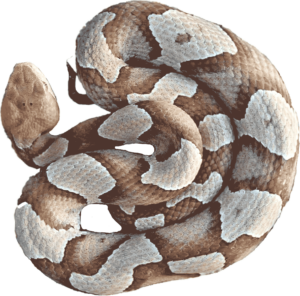
- Its venom contains proteins and enzymes that can cause tissue damage, pain, swelling, and, in severe cases, systemic effects such as nausea, vomiting, and low blood pressure.
- The eastern copperhead has one of the best camouflage patterns in the fall woods, with hourglass bars that alternate between dark and light coppery brown, It has a spade-shaped head and slanted eyes.
- The Eastern Copperhead is less dangerous than most pit vipers, but more common in Arkansas so 2/3rds of all bites are from these guys. Only .01% result in fatalities.
- The Eastern Copperhead is a venomous pit viper found in the Buffalo River and Ozark National Forest.
- Northern Cottonmouth:
- The Northern Cottonmouth, also known as the water moccasin, is a venomous snake often found in and
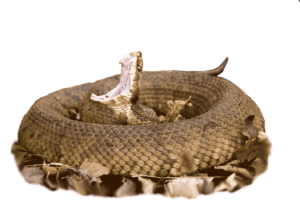 around water bodies in Buffalo River and Ozark National Forest.
around water bodies in Buffalo River and Ozark National Forest. - Its venom is cytotoxic and can cause tissue damage, pain, swelling, and potential systemic effects.
- They have a dark stripe across their eye that I like to refer to as a mask of Zorro. Juvenile cottonmouths and copperheads also have a greenish yellow tip to their tails that they use as a lure to draw curious animals close enough for a bite.
- On average there are around 255 cottonmouth bites reported in the whole US, but only ten serious outcomes and no deaths.
- The Northern Cottonmouth, also known as the water moccasin, is a venomous snake often found in and
- Timber Rattlesnake:
- The Timber Rattlesnake is a venomous pit viper found Buffalo River and Ozark National Fo
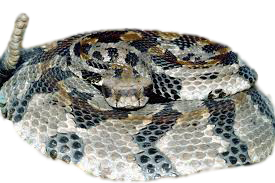 rest.
rest. - Its venom contains a combination of toxins that can lead to pain, swelling,
- tissue damage, and, in some cases, systemic symptoms like nausea, dizziness, and low blood pressure.
- Timber rattlers are typically more brown or yellowish and may even be black. Both forms have solid black tails that appear almost velvet and black chevrons on the back and sides with the point of the (V) pointing forward. It has a spade-shaped head and slanted eyes.
- The Timber Rattlesnake is a venomous pit viper found Buffalo River and Ozark National Fo
- Western Diamond-backed Rattlesnake:
- The Western Diamond-backed Rattlesnake is a venomous pit viper found Buffalo River and Ozark National Forest.
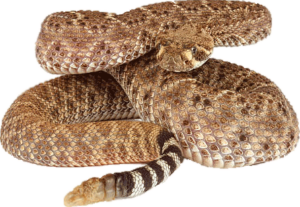
- Its venom is a potent hemotoxin that can cause severe tissue damage, pain, swelling, and other systemic effects.
- There are two dark diagonal lines on each side of its face running from the eyes to its jaws. It has dark diamond-shaped patterns along its back. It has a spade-shaped head and slanted eyes.
- The Western Diamond-backed Rattlesnake is a venomous pit viper found Buffalo River and Ozark National Forest.
- Western Pygmy Rattlesnake:
- The Western Pygmy Rattlesnake is a small venomous rattlesnake found in the Buffalo River and Ozark National Forest.
- While its venom is not as potent as that of larger rattlesnake species, it can still cause pain, swelling, and tissue damage.
- Western pygmy rattlesnakes have the red-brown stripe down the back, similar to timber rattlesnakes, but they are
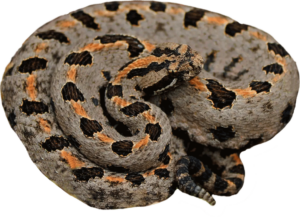 much smaller and have small, button rattles at the tips of their tails.
much smaller and have small, button rattles at the tips of their tails. - It has a gray to pinkish body with dark blotches down its back and one to three rows of spots along each side. It has a spade-shaped head and slanted eyes.
Though the rattle snakes result in a higher precent of death their bits are much rarer than the cottonmouth and copperhead and they like to warn with their rattler before they strike giving you the opportunity to avoid them.
6. Texas corral snake:
-
- The Texas corral snake is said to only be in the southern part of Arkansas. Though incredibly rare, I have heard
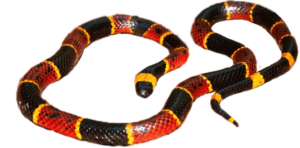 stories and seen pictures of people finding them in the Buffalo River, Ozark National Forest area.
stories and seen pictures of people finding them in the Buffalo River, Ozark National Forest area. - This snake does NOT have slanted eyes or a spade head and there is a non-venomous snake (Scarlet Snake) that looks a lot like it. Both the coral snake and the scarlet snake can be found in parts of Arkansas and are red, yellow, and black. My wife always says, “Red touch Yellow, kill a fellow”. If the red and the yellow on the snake are touching it is poisonous. Best to avoid all snakes if you can.
- The Texas corral snake is said to only be in the southern part of Arkansas. Though incredibly rare, I have heard
If you get bit:
- Circle where the snake bite occurred.
- Write the time that it happened.
- Write down any identifying marks you noticed about the snake.
- If bite on the hand or arm, remove rings and watches before swelling starts.
- Write the time of any symptom you get and what it is. This will help ensure your survival once you get medical help.
- Get to the hospital as fast as possible. But better than speeding, have your buddy call ahead and find where the closest place with the antivenom is.
You DO NOT need to:
- Suck the poison out.
- Kill the snake.
If someone can get a picture that would be helpful but not necessary as CroFab antivenom works for all these pit viper snakes and that’s what they keep at the local hospitals.
Explore with
confidence
Inspiration and guidance for wherever your trail may lead.
